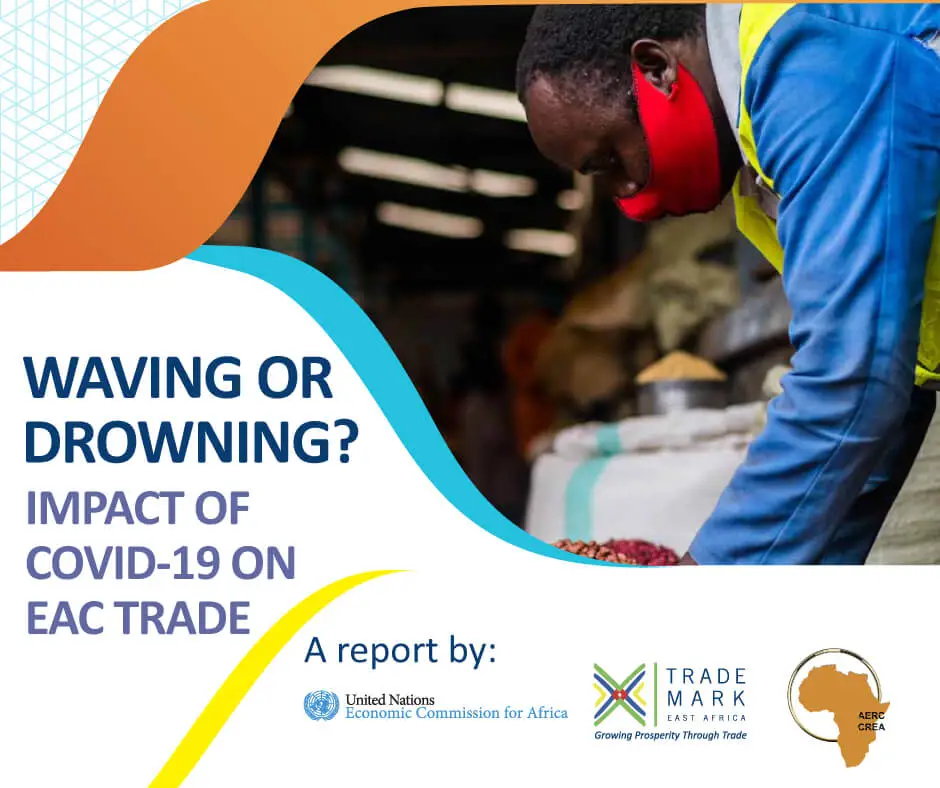When the COVID-19 pandemic crisis started; most people were extremely pessimistic and predicted that the EAC region would drown in terms of trade declining catastrophically. But in fact, the East Africa Community economies (Burundi, Kenya, Rwanda, South Sudan, Tanzania, and Uganda) have, by global standards, proven to be relatively resilient.
The newly launched joint report by UN Economic Commission for Africa (UNECA), TradeMark Africa (TMA) and African Economic Research Consortium (AERC) entitled “Waving or Drowning? The Impact of the COVID-19 Pandemic on East African Trade” notes that declines in imports broadly reflected the adverse trade performance of the EAC’s main trading partners during the early phases of the pandemic in April and May 2020, but the imports of all the EAC Partner States subsequently recovered to pre-pandemic levels by the second half of 2020, after governments’ lockdown restrictions were eased, and a broader global trade recovery started to take place.
Nonetheless, despite showing resilience, COVID-19 has reversed some of the gains made in trade facilitation.
Immediately after COVID-19 outbreak, the ship dwell time at Mombasa port increased by 48% and Berth time increased by 52%. Cargo transit from Mombasa Port to Malaba (the border between Kenya and Uganda) increased from 7 days to 11 days by the second quarter of 2020. The time taken to transport goods via the Mombasa-Busia route was nearly three times higher. On the Central Corridor, the transit time from Dar-es-Salaam to various cities in the neighbouring countries more than doubled. The marked increase in transit times highlights the challenges at border points.
Another major casuality from the crisis has been informal cross-border trade, which has struggled to recover from the regional restrictions on cross-border travel. For example, data from Uganda suggests that value of informal cross border trade declined from US$44 million to US$1.5 million and even the reopening of Uganda’s borders in September 2020 did not revive informal cross border trade. The resultant impacts include loss of income in border communities and a reversal of women economic empowerment.
The report provides a set of recommendations for public and private sector to steer the region’s economies to greater stability post COVID-19.
One of the key recommendations is for the EAC Partner States need to continue providing financial and regulatory support to key export sectors and more so to those that have shown resilience since the advent of the pandemic. The EAC Partner States also need to double-down on policies to diversify their economies. This is because, excessive commodity export dependence still exposes the regional economy to unnecessary risks. The African Continental Free Trade Area (AfCFTA) could be instrumental in achieving this goal.
The reports urge policy makers to support development and implementation of technological innovations to address the bottlenecks that have arisen during the crisis along the Northern and Central Corridor. It cites the example of Regional Electronic Cargo Tracking System (RECDTs) which facilitates issuance of jointly recognised health certificates by EAC partner states thus eliminating the need for multiple tests for truck drivers. This has contributed to reduced delays at border points. Other technological innovations that support paperless trade will deliver time and cost benefits to the region post-COVID19 as well as support regional integration.
The pandemic has exposed vulnerability of certain global value chains. The resilience exhibited by EAC intra-regional trade and the opportunities attests to the importance of strengthening regional value chains (RVCs) particularly as the region moves into the implementation stage of the African Continental Free Trade Area (AfCFTA).
EAC governments and other relevant stakeholders should address the challenges facing informal cross-border traders. The pandemic has had a severe negative impact on communities that are heavily dependent on cross-border informal trade.
From a trade perspective, the region is still not out of the woods. The pandemic’s rapidly evolving nature and its spillover effects may still present a significant threat to trade and commerce within the EAC over the coming years. Partner States must continue with a tightly coordinated approach to addressing the pandemic’s challenges.


